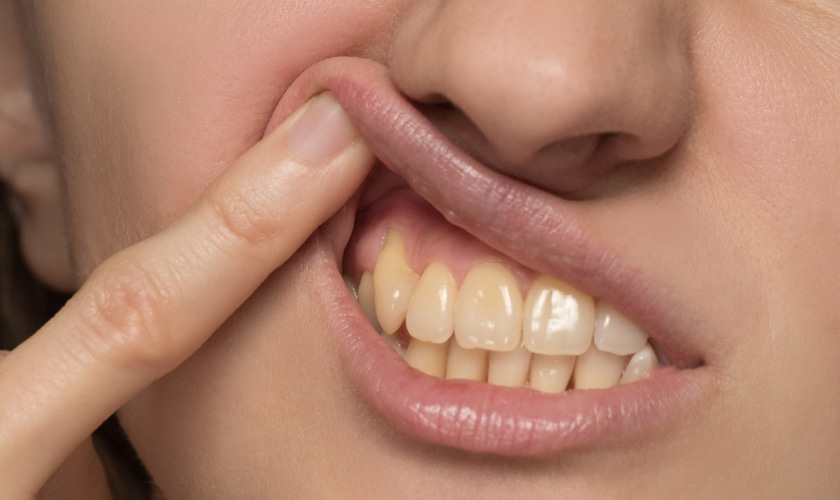
Are you a smoker who’s been turning a blind eye to the negative effects of smoking on your oral health? You might want to think twice before lighting up that cigarette again. Smoking not only poses serious harm to your lungs and heart but is also one of the leading causes of gum disease. In this blog post, we’ll dive into how smoking can increase your risk of developing gum disease and what steps you can take to protect yourself from its devastating consequences. So, buckle up, and let’s get started!
What is Gum Disease?
Smoking is a leading cause of periodontal disease, also known as gum disease. Gum disease is an infection of the tissues that support your teeth. It’s usually caused by plaque, a sticky film of bacteria that constantly forms on your teeth. If plaque isn’t removed, it can harden into tartar, which is much harder to remove.
Gum disease begins with gingivitis, which is when your gums become inflamed and bleed easily. If gingivitis isn’t treated, it can progress to periodontitis, which is when the gum tissue and bone around your teeth start to break down. This can eventually lead to tooth loss.
Smokers are more likely to develop gum disease because smoking decreases the amount of saliva in your mouth. Saliva helps keep your mouth clean and healthy by washing away food and bacteria. Smoking also makes it harder for your body to fight off infections.
If you smoke, you should see a dentist regularly so they can check for signs of gum disease. You may also want to consider quitting smoking to reduce your risk of developing gum disease and other serious health problems.
Causes of Gum Disease
Smoking is a major cause of gum disease. In fact, smokers are six times more likely to develop gum disease than non-smokers. Smoking damages the gums and teeth in a number of ways. It increases the build-up of plaque, a sticky film of bacteria that forms on teeth. Plaque produces toxins that damage the gums and cause them to swell and bleed. Smoking also interferes with the body’s ability to fight infection and repair tissue damage. This means that smokers are more likely to develop infections, including gum infections. Gum disease is serious and can lead to tooth loss. If you smoke, quitting is the best thing you can do for your oral health.
Smoking and Gum Disease
Smoking is a known risk factor for many health conditions, including gum disease. Gum disease is an infection of the gums that can damage the soft tissue and bone that support the teeth. Smoking makes it harder for the body to fight off infection and can make gum disease worse.
There are two types of gum disease: gingivitis and periodontitis. Gingivitis is a milder form of gum disease that can be reversed with good oral hygiene. Periodontitis is a more severe form of gum disease that damages the bones and tissues that support the teeth. Periodontitis can lead to tooth loss if it is not treated.
Smokers are more likely to develop periodontitis than nonsmokers. They are also more likely to have more severe gum disease and lose more teeth than nonsmokers. Smoking also increases the risk of other problems such as mouth cancer.
If you smoke, quitting smoking is one of the best things you can do for your oral health. There are many resources available to help you quit smoking, including counseling and medication. Your dentist or doctor can help you find the resources you need to quit smoking for good.
Symptoms of Gum Disease
Smoking is a major risk factor for developing gum disease. Symptoms of gum disease include:
-Red, swollen, or tender gums
-Bleeding gums when brushing or flossing
-Gums that pull away from the teeth
-Persistent bad breath
-Pus between the gums and teeth
-Loose teeth
If you are a smoker and experience any of these symptoms, it is important to see your dentist right away. Gum disease is a serious condition that can lead to tooth loss if it is not treated.
Treatment for Gum Disease
Smoking is a major risk factor for developing gum disease. Gum disease is an infection of the gums that can lead to tooth loss. Treatment for gum disease includes professional dental cleanings, medications, and surgery. quitting smoking is the best way to reduce your risk of developing gum disease.
Prevention of Gum Disease
The best way to prevent gum disease is to quit smoking. Smoking is a major risk factor for developing gum disease, so quitting will dramatically reduce your chances of developing the condition. If you are unable to quit smoking, there are still steps you can take to reduce your risk of gum disease. These include:
-Brushing and flossing regularly
-Seeing your dentist regularly for cleanings and checkups
-Not using tobacco products
Alternatives to Smoking
There are many alternatives to smoking, and each person will find what works best for them. Some people may find that quitting smoking entirely is the best option, while others may find that switching to a less harmful form of tobacco is a better choice. There are also many non-tobacco options available for those who want to quit smoking.
E-cigarettes have become a popular alternative to traditional cigarettes in recent years. These devices allow users to inhale nicotine without exposure to the harmful tar and chemicals found in cigarettes. E-cigarettes are not risk-free, but they are generally considered to be much safer than traditional cigarettes.
Smokeless tobacco products, such as chewing tobacco and snus, are another alternative to smoking cigarettes. These products do not produce smoke, so they eliminate exposure to secondhand smoke. However, smokeless tobacco still contains nicotine and other harmful chemicals, so it is not a completely safe option.
There are also many non-tobacco options available for those who want to quit smoking. These include nicotine replacement therapy products like patches and gum, as well as prescription medications like bupropion and varenicline. These products can help reduce withdrawal symptoms and make quitting smoking easier.
Conclusion
Smoking has consistently been linked to an increased risk of developing gum disease. Its effects on the body can be devastating and long-lasting, so it’s important for smokers to understand their risks and seek help if necessary. With proper dental care, you can reduce your chances of developing gum disease. Quitting smoking is also crucial in order to protect yourself from serious health complications like gum disease as well as other conditions such as cancer or heart attack. A commitment to quitting smoking and good oral hygiene are essential steps toward good overall health!
Smoking cigarettes or using other tobacco products can contribute to the development of gum disease. The nicotine in tobacco products can reduce blood flow to your gums, making them more susceptible to infection. In addition, smoking can make it harder for your body to fight off infection.
Gum disease can cause your gums to become red, swollen, and bleed easily. You may also experience pain when chewing or bad breath. If you notice any of these symptoms, please see your dentist as soon as possible.
There are several things you can do to help prevent gum disease, including quitting smoking, brushing and flossing regularly, and visiting your dentist for regular checkups and cleanings.


